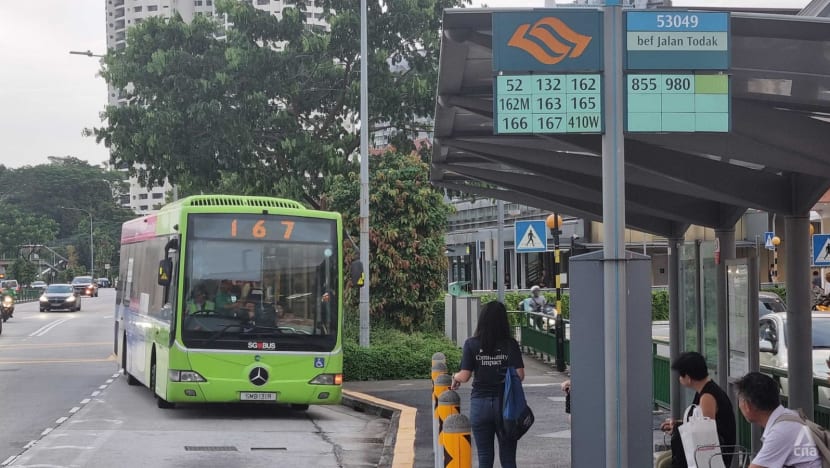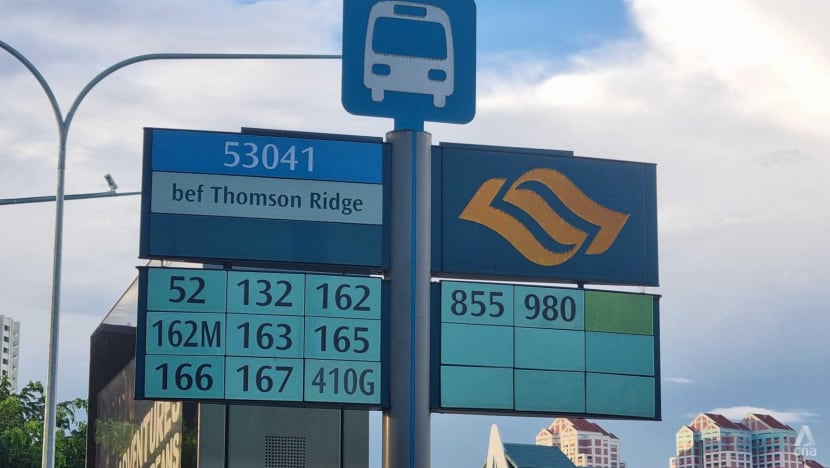Changes to bus services like 167 'inevitable' for cost efficiency, say transport experts
With the expansion of Singapore's MRT network, transport experts expect more bus services to be adjusted to reduce duplication in routes.

Bus service 167 at a bus stop along Upper Thomson Road. (Photo: CNA/Suen Wai Kit)

This audio is generated by an AI tool.
SINGAPORE: Any decision to remove public bus services may upset commuters but it is inevitable that Singapore would have to adjust bus routes with the expansion of the country's train network, transport experts said on Wednesday (Nov 29), citing the need to manage costs.
The Land Transport Authority (LTA) announced on Nov 17 that it would discontinue bus service 167 given falling ridership, sparking criticism from some commuters. However, just days after the announcement, the authority reversed its decision and said bus service 167 would operate at 30-minute intervals for the time being, from Dec 17.
"I think it's inevitable that bus services will continue to need to be rationalised given expansion to the MRT system," said Associate Professor Walter Theseira of the Singapore University of Social Sciences (SUSS).
"The point of building the MRT network is to provide a much higher capacity, higher quality of transport services, than can be provided by bus services. That is why the MRT network is being expanded rather than just buying more buses, even though the MRT is substantially more expensive," he added.
"Thus, if there is a strong degree of substitution between the MRT network and a given bus service, that bus service should be considered for adjustment."
LTA said earlier this month that demand for "long trunk services" such as bus 167, along with service 162/M and 75, had fallen 30 per cent to 40 per cent along the sectors that run parallel to the Thomson-East Coast Line.
Given the low ridership for these bus services, it would be inefficient for the transport authority to pay operators to run these routes, experts said.
"The challenge is entirely on public finances," Assoc Prof Theseira explained.
"When a service is run with too few passengers, the difference between LTA's operations fees and the fares received is larger, and the taxpayer has to pay more to support public transport."
Singapore's public transport network "currently has a high incidence of routes that overlap and duplicate for some distance", noted Adjunct Associate Professor Paul Barter of the Lee Kuan Yew School of Public Policy (LKYSPP).
"This inefficiency makes it difficult to offer frequent service at reasonable cost," he added.
Associate Professor Raymond Ong of the Department of Civil and Environmental Engineering at the National University of Singapore (NUS) also told CNA that he expects more bus services to be adjusted in future.
"We should not have routes that are competing with each other for the same demand," said Dr Ong.
When asked about whether it was unusual for LTA to reverse its decision on bus service 167, Assoc Prof Theseira said it is difficult for the agency to predict how extensive opposition will be to any bus service adjustment.
He noted that in choosing the services to adjust, the decision should not result in substantial disruption or a significantly lower quality of service for commuters.
LTA said on Nov 17 that changes in ridership were analysed and the availability of travel alternatives to the affected bus services was also considered.
"But there will obviously still be commuters negatively affected by rationalisation, and it may not be easy to predict how large or dissatisfied that group will be until plans for rationalisation are published," Assoc Prof Theseira said.

BALANCING COSTS AND LOSS OF DIRECT BUS ROUTES
Some commuters CNA spoke to earlier this month lamented the loss of a direct bus connection to their destination as they do not live near an MRT station.
Acknowledging this concern, Dr Barter noted that reducing bus service duplication also means that more journeys would include having to make a connection.
"So such reforms are always controversial," he added. "People who lose a one-seat ride that they are used to are understandably upset, even if their connection has short waiting times."
But ultimately, such adjustments to public transport services could bring larger benefits overall, the experts said.
"If done well, a reformed network could enable shorter bus waiting times without increasing costs. Short waiting times are valued highly by public transport users. They also make connecting between services less time-consuming," said Dr Barter.
Assoc Prof Theseira added: "In the end, the rationalisation is to save costs for the entire public transport system. This is a win for everyone in Singapore and taxpayers, but it is a loss for the affected commuters."
IMPROVING ACCESS TO MRT STATIONS
LTA could look into whether other services can be improved to provide better connectivity to neighbourhoods that are not within walking distance of an MRT station, said NUS' Dr Ong.
He added that the infrastructure should be more accessible for commuters with limited mobility such as the elderly and people with disabilities.
Assoc Prof Theseira noted that paratransit services - public-subsidised taxis or point-to-point shuttles for those who cannot easily access standard public transportation - could be considered.
"But to manage costs, we would probably need to define some level of public transport service quality threshold (e.g. a minimum distance between the home and the nearest public transport point) before someone qualifies," he added.
"The other way of addressing the problem is with what has already been taking place with urban planning and local infrastructure development - to site key destinations such as health facilities and public institutions near MRT stations, to develop sheltered barrier-free walkways."
















